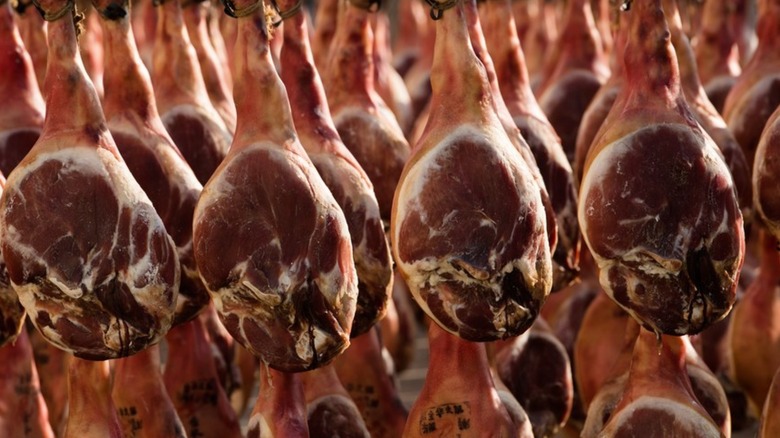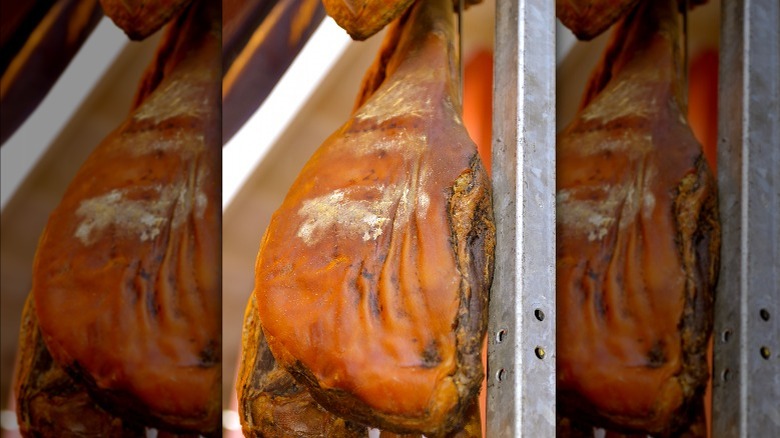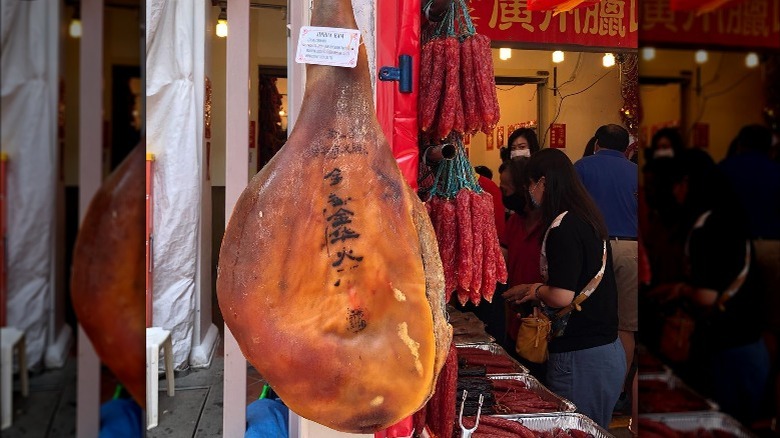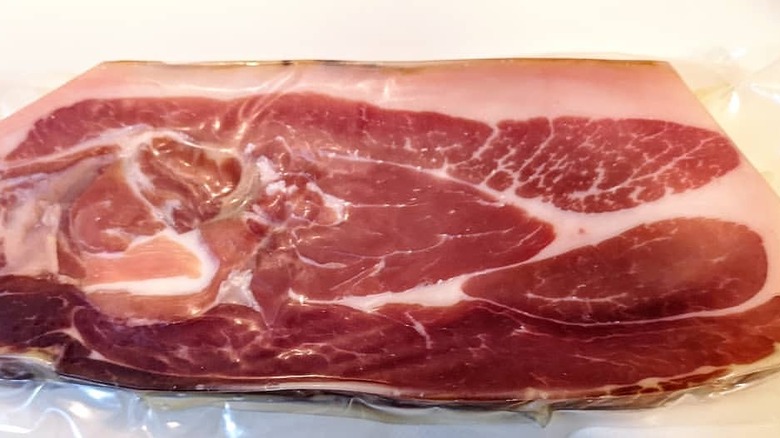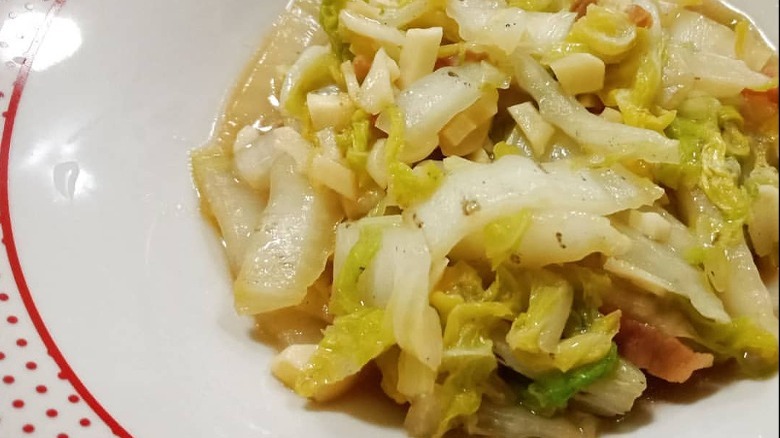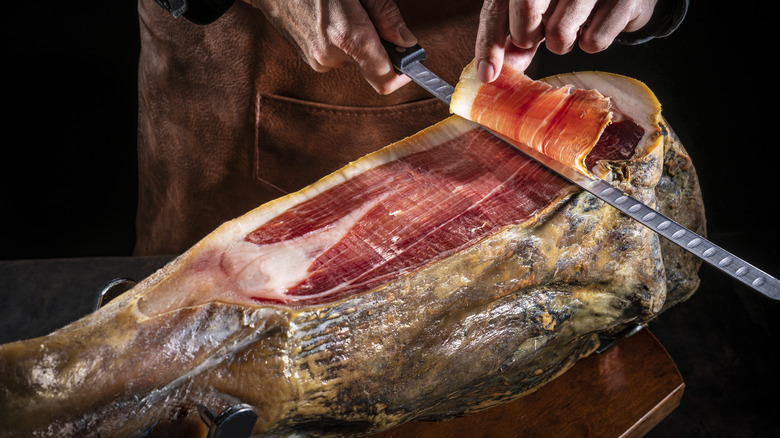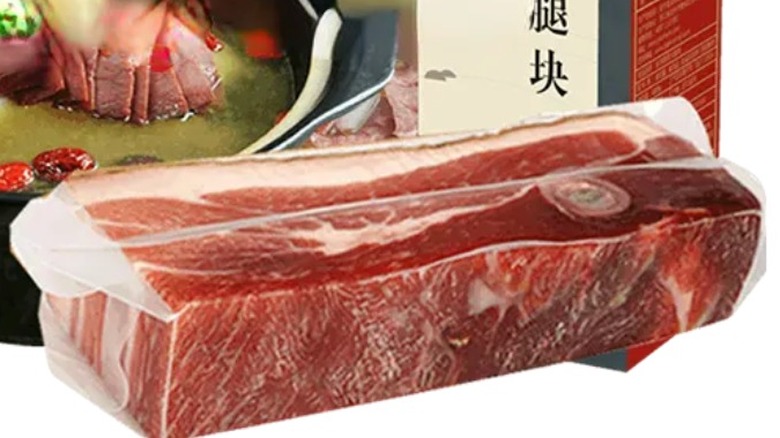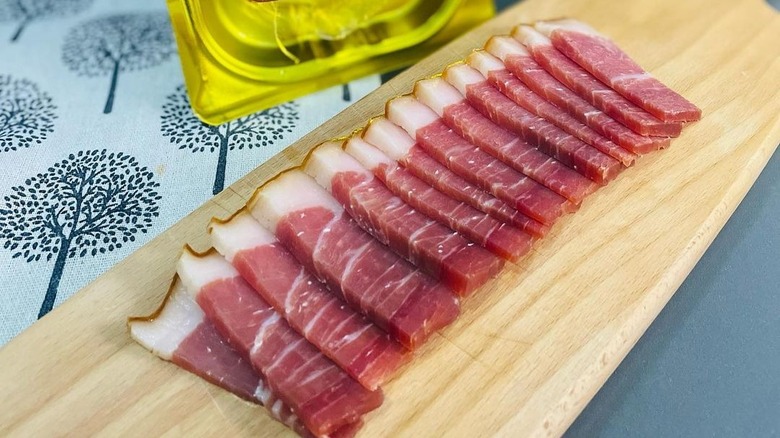Jinhua Ham Has Been A Chinese Delicacy For Over 1000 Years
The eastern coastal Chinese province of Zhejiang is home to the city of Jinhua, where a ham that has been made for more than 1,000 years continues to enthrall foodies not just around the area, but around the world. Unlike the soft hams that we find in many butchers and restaurant kitchens throughout the U.S. and Europe, Jinhua ham packs an intense flavor and rather firm flesh, making it closer in style and substance to Ibérico ham and Prosciutto di Parma. Some believe the preparation and processes that result in these succulent hams may have been the result of one of the earliest examples of food manufacturing transfer, thanks to the effort of Marco Polo, who had visited Jinhua during his stay in China.
Unlike most stand-alone hams consumed in the west, the Jinhua version is primarily used to increase and improve the overall flavor of a dish. As such it is frequently added to soups, broths, and stir fries.
History of Jinhua ham
Jinhua ham dates back to the Tang Dynasty, which was at the helm of China from 618 to 907 C.E. The staple was born out of need; curing meat was the only way to keep it from spoiling and soldiers regularly salted pork legs to ensure they had provisions when they were required to go on the road. But this ham was considered to be so tasty it eventually appeared at the imperial palace as a gift from a famous scholar to China's ruler. The emperor fell in love with the its flavor and distinctive red hue, so much so that he named it "huo tui" (fire leg).
The Jinhua ham that gave the emperor so much pleasure isn't the same one that is served today. Traditionally it was made with the hind legs of a local variety of pig known as the liangtouwu, or panda pig, which had a black head and rump. But while the pig was once favored for its small size and high fat content, producers have stopped using it because the species has become difficult to source, and other types of fatty pigs are now used in its place.
How Jinhua ham is made
Like other specialty meats, Jinhua hams are considered to be a product of both technique, which has been refined through generations, and terroir, which features a combination of topography, temperature, and humidity. Even though these hams are no longer made with liangtouwu pigs, they must still be made with hind legs that exhibit qualities including thin skin, a slight layer of white fat, good muscle tone, and a slim, unbroken shank bone. In order to become authentic Jinhua hams, these legs are trimmed so that they are shaped like bamboo leaves; they are then salted every 25 to 35 days for a total of six times. Once those steps are completed, the ham is washed, dried, and shaped, then placed in a dark, temperature and humidity controlled environment for between six to eight months to ferment before experts test it to determine its quality.
When it comes to the highest quality, timing is everything, making preparations particularly intense. Jinhua ham factory owner Yin Bing Zhu tells SBS Australia, "Our ham can only begin salting in winter. We salt the legs from December to January, and wash the legs in January when it is cold and there are no flies around."
What jinhua ham tastes like
The exact amount of salt that is used to create the perfect iteration of Jinhua ham is a secret — that knowledge is only held by Jinhua ham masters who often study for 10 to 15 years to learn their craft. Specific salting technique is an important step in the making of Jinhua ham, since using the wrong quantities of salt could ruin the product. Given that each ham is salted at least six times, you wouldn't be wrong in assuming that the cured meat can be very salty, especially in a case where it is not well made.
Otherwise, the flavor of Jinhua ham is often described as smoky and nuanced — definitely saltier on top, but with a touch of sweetness to it as well. It's well-known for its pungent aroma and can exhibit more subtle yet complex flavors as you cut through the skin and fat to get to the flesh beneath.
How to cook with Jinhua ham
It's worth pointing out that the flesh of the Jinhua ham is both dense and dry — a direct result of the months-long fermentation process. Because of this, the ham can be a challenge to use on its own. "Jinhua ham is complicated to cook with," Yin Bing Zhu explains to SBS Australia. "It's not the main food but more of a flavor enhancer." As such, it's more often used as an ingredient to make soup stock or to provide a pop of flavor to steamed dishes. It can even be used as a flavoring for stir-fried dishes, and as an essential ingredient to bring life to fried rice.
Still, there are those who enjoy a slice of the ham just as it is, and some fans say its good to steam the ham before eating, since that will soften the meat. Other fans have been known to cut thin slivers to enjoy as a sandwich with bread.
Jinhua ham and its European cousins, prosciutto and Ibérico ham
Some chefs, like Melbourne's Tony Tan, have pointed out that the differences between Jinhua ham, Ibérico jamón, and Prosciutto di Parma can be slight. "I'll use jamón or sometimes prosciutto in place of Jinhua ham ... Jinhua ham is drier than jamón, so it depends how you use the [other] ingredients. I use jamón in my XO sauce and more elegant Chinese dishes," Tan shares with SBS Australia.
The similarities between the three could come down to the way they are made. Like Jinhua ham, Ibérico hams are salted before they are washed and left to rest in cold rooms. They are then dried for as long as 12 months; this hydration period is when they are said to develop their unique flavor. Prosciutto production makes use of a similar method of salting, resting, washing, and curing the ham, except that the Italian method also calls for adding a layer of lard, salt, and pepper to keep the ham from drying out. It seems like no coincidence that all three specialties are made in similar ways when we remember Marco Polo discovering the process in Jinhua back in the 13th century.
Nutritional information about jinhua ham
When consumed on its own, a 1 ounce portion of Jinhua ham packs 90 calories, 8 grams of fat, a trace amount of carbs, and 66 milligrams of sodium. Dry-cured ham is also considered a good source of iron and zinc as well as other essential minerals like phosphorous, potassium, magnesium, and selenium, all of which are bioavailable in this type of meat and, therefore, potentially beneficial, according to Jamon.com. In protein content, though, Jinhua ham punches above its weight. Every ounce contains 4.6 grams of protein. In addition, dry-cured ham is an excellent source of vitamin B12.
And while the ingredient is purely enjoyed as a food item these days, Jinhua ham was once prized by Traditional Chinese Medicine practitioners as a cure for a number of diseases, including fatigue, dysentery, and diarrhea, although scientists are not exactly clear why this should be the case, notes a 2012 study from Animal Frontiers.
Where to buy Jinhua ham
While it is definitely considered a delicacy in its home country and by chefs in the know worldwide, it can be very difficult to find Jinhua ham outside of China because it is not sold in many countries and is actually banned in the U.S. Part of this is likely related to safety concerns, since some farmers in China have been known to make use of banned substances to raise their animals, like clenbuterol, a medication which the FDA has not approved for use by humans (via Healthline).
However, the ham can be purchased in countries like Singapore where the product is offered in limited quantities through online stores. The product can also be found in Malaysia as well as in Hong Kong. Jinhua hams are usually sold in vacuum sealed plastic; buyers are advised to keep the ham wrapped in plastic and to store the meat in the refrigerator, since it needs a cool environment to keep from spoiling.
